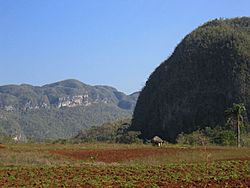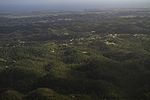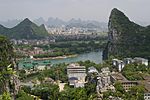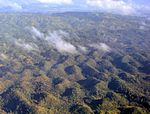Mogote facts for kids
A mogote (/məˈɡoʊti/) is a generally-isolated steep-sided residual hill in the tropics composed of either limestone, marble, or dolomite. Mogotes are surrounded by nearly flat alluvial plains. The hills typically have a rounded, tower-like form.
Overview
This term is used for hills, isolated or linked, with very steep, almost vertical, walls, surrounded by alluvial plains in the tropics, regardless of whether the carbonate strata in which they have formed are folded or not.
Mogotes are common in tropical and subtropical karst areas around the world, which is that of southern China, the Southeast Asian countries of Indonesia, Laos, Malaysia, Myanmar, the Philippines, Thailand, and Vietnam; as well as the Caribbean, especially in Cuba and Puerto Rico. Los Haitises National Park in the Dominican Republic is another karst area that contains mogotes.
The word mogote comes from the Basque word 'mokoti' meaning "sharp-pointed" ('moko' meaning "mountain peak"). In Puerto Rico, several mogotes along a ridge are called pepinos.
Gallery
-
Mogotes in Puerto Rico rising out of pineapple fields in a plain of blanket sand near Coto Sur. The quarry in the left background is 1 kilometer east of Manati.
-
Two mogotes showing their typical rounded shape in Viñales Valley in Pinar del Río Province, western Cuba
-
Mogotes, Northern Matanzas Province, near the city of Cárdenas, Cuba
-
View of mogotes along the Northern karst zone of Puerto Rico.
-
Mogotes in Sector Hess in Esperanza, Arecibo, Puerto Rico.
-
Aerial view of the Chocolate Hills, Bohol, Philippines, exhibiting both mogotes and cockpit karst characteristics.
-
Mogotes, Krabi Province, southern Thailand.
-
Islets of mogotes in Ha Long Bay, Vietnam.
See also
 In Spanish: Mogote para niños
In Spanish: Mogote para niños
- Areas
- Chocolate Hills, Philippines
- Hin Namno, Laos
- Kinta Valley, Malaysia
- Krabi Province, Thailand
- Los Haitises, Dominican Republic
- Northern Karst Region, Puerto Rico
- Phong Nha-Ke Bang, Vietnam
- South China Karst, China
- Viñales Valley, Cuba












